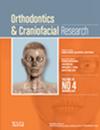Bone Thickness and Density at the Infra Zygomatic Crest and Lateral Wall of Pyriform Aperture in Various Age Groups: A Cone Beam Computed Tomography-Based Study
Abstract
Objectives
The objective of this study was to determine and compare the bone thickness and density at the infra-zygomatic crest (IZC) and the lateral wall of the pyriform aperture (PA) among various age groups.
Methods
A cross-sectional study was conducted on the cone beam computed tomography (CBCT) images of 90 subjects divided into three equal groups, that is, adolescents, post-adolescents and adults. At IZC, the bone thickness and density were measured at four sections and at four vertical levels (Z1 to Z4) with Z1 at the apical level of M1 and every next level moving superiorly with an increment of 2 mm. At PA, bone thickness and density were measured at two sections (3 mm and 6 mm from outer border of lateral wall of PA). Measurements were compared between males and females using an independent sample t-test and among three age groups using a one-way ANOVA test.
Results
At IZC, bone thickness was greatest at the Z1 level and mesial to and above the mesiobuccal root of M1. At PA, maximum bone thickness was found at 6 mm from the lateral wall of PA. The mean bone thickness and density at all sections of IZC were generally more in adults. However, at PA, bone thickness was found to be greater in adolescents.
Conclusions
Maximum bone thickness at IZC was found just above and mesial to the mesiobuccal root of M1. At the lateral wall of PA, more bone thickness was found at 6 mm from the outer border of PA. Bone thickness generally increased with age at IZC and decreased with age at the lateral wall of PA.

 求助内容:
求助内容: 应助结果提醒方式:
应助结果提醒方式:


